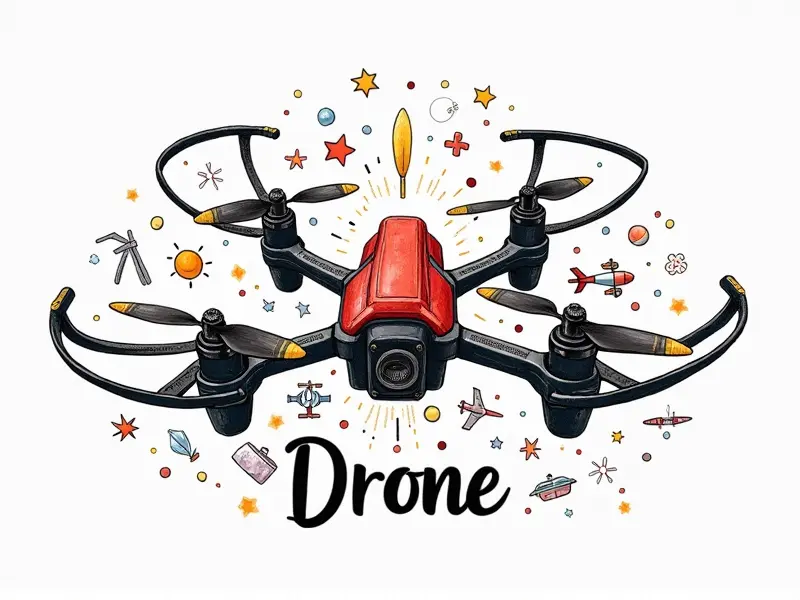How does an RC quadcopter work?

RC quadcopters, also known as multirotor drones, have become increasingly popular in recent years due to their versatility and ease of use. These unmanned aerial vehicles (UAVs) are capable of performing a wide range of tasks, from aerial photography to surveillance and even racing. But how exactly do these marvels of technology achieve flight? In this article, we will delve into the mechanics behind RC quadcopters to understand their inner workings.
Inside the Mechanics of RC Quadcopters
The heart of an RC quadcopter lies in its mechanical components and electronic systems. At a basic level, a quadcopter consists of four rotors (or propellers), each mounted on a motor. These motors are powered by an onboard battery system, which provides the necessary energy for flight.
How Do RC Quadcopters Really Work?
To understand how RC quadcopters work, it's essential to break down their functionality into simpler components and processes. The primary mechanism that enables a quadcopter to fly is the balance between lift generated by its rotors and gravity pulling it downward.
Understanding RC Quadcopter Operation Basics
The basic principle of operation for an RC quadcopter involves four main factors: thrust, torque, pitch, and yaw. Thrust is produced by spinning propellers that push air downwards, creating lift. Torque refers to the rotational force generated by these spinning rotors, which helps in maneuvering the drone.
Thrust
The thrust generated by each rotor is crucial for maintaining flight. By adjusting the speed of individual motors, a pilot can control how much lift each propeller produces, allowing precise adjustments to altitude and stability.
Torque
Torque affects the rotation of the quadcopter around its vertical axis (yaw). To counteract torque-induced spin, modern quadcopters use an asymmetrical rotor setup where two rotors turn clockwise and the other two counterclockwise. This arrangement ensures that any rotational force is balanced out.
Breaking Down RC Quadcopter Functionality
The functionality of an RC quadcopter extends beyond just mechanical components; it also relies heavily on sophisticated electronics and software systems. Key elements include:
- Flight Controller: A microcontroller that processes sensor data to maintain stability.
- Sensors: Gyroscopes, accelerometers, barometers, GPS modules, and magnetometers provide critical information about the drone's orientation and position.
- Battery Management System (BMS): Monitors battery voltage and temperature to ensure safe operation.
- Radio Receiver: Receives control signals from a remote transmitter.
RC Quadcopter Mechanics Simplified
To simplify the mechanics of an RC quadcopter, consider it as a system where four motors work in harmony to achieve flight. Each motor is responsible for one propeller, and by varying their speeds, the drone can perform complex maneuvers.
Propellers
The direction and speed of each propeller are crucial. Two propellers spin clockwise (CW), while the other two spin counterclockwise (CCW). This setup ensures that any rotational force is balanced out, allowing for stable flight.
How RC Quadcopters Achieve Flight
The process of achieving flight involves several steps:
- Pilot Input: The pilot uses a remote control to send commands to the quadcopter.
- Sensor Data Collection: Various onboard sensors gather information about orientation, altitude, and position.
- Data Processing: A flight controller processes this data in real-time to make adjustments necessary for stable flight.
- Motor Control: Based on the processed data, motor speeds are adjusted to maintain stability and execute maneuvers.
Mastering the Inner Workings of RC Quadcopters
To truly master the inner workings of an RC quadcopter, one must understand how each component interacts with others. By learning about flight dynamics, sensor integration, and control algorithms, enthusiasts can build their own custom drones or improve existing ones.
Flight Dynamics
Understanding flight dynamics involves studying lift generation, thrust-to-weight ratio, and aerodynamic principles that govern the behavior of quadcopters in different conditions.
Understanding RC Quadcopter Technology
The technology behind RC quadcopters is constantly evolving. Advancements in materials science, electronics, and software development have led to more efficient and capable drones. Key technological advancements include:
- Better Batteries: Higher capacity and faster charging batteries.
- Sophisticated Sensors: Enhanced accuracy and reliability of onboard sensors.
- Advanced Flight Algorithms: Improved stability, agility, and autonomous flight capabilities.
Secrets of RC Quadcopter Operation
The secrets to successful operation lie in balancing the forces acting on the drone. By fine-tuning motor speeds and adjusting control inputs, pilots can achieve smooth and responsive flight performance.
Balancing Forces
Maintaining equilibrium between lift, thrust, drag, and gravity is crucial for stable flight. Pilots must learn to anticipate changes in these forces and make quick adjustments accordingly.
RC Quadcopter Flight Control Simplified
To simplify the concept of flight control, think of it as a continuous feedback loop where sensor data informs motor speed adjustments. This process ensures that the drone remains stable despite external disturbances like wind or changes in payload weight.
Feedback Loop
The flight controller continuously monitors and adjusts motor speeds based on real-time sensor readings to maintain stability and execute commands accurately.
Exploring the Tech Inside RC Quadcopters
Exploring the technology inside an RC quadcopter reveals a complex yet fascinating system of interconnected components working together seamlessly. From advanced electronics to cutting-edge software, every aspect contributes to the overall performance and reliability of these aerial marvels.
Electronics Integration
The seamless integration of various electronic modules ensures that all systems work in harmony, providing pilots with precise control over their drones.
Conclusion
In conclusion, understanding how an RC quadcopter works involves delving into its mechanical components, electronic systems, and sophisticated flight algorithms. By mastering the inner workings of these devices, enthusiasts can appreciate the complexity and elegance behind this modern marvel of technology. Whether you're a hobbyist or professional drone operator, gaining insight into the mechanics of RC quadcopters will undoubtedly enhance your appreciation for their capabilities.

